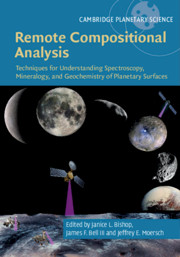 Remote Compositional Analysis
Remote Compositional Analysis Theory and Applications
from Part I - Theory of Remote Compositional Analysis Techniques and Laboratory Measurements
Published online by Cambridge University Press: 15 November 2019
Imaging radars are all-weather instruments that can image planetary surfaces regardless of local atmospheric or solar illumination conditions. Radar images provide information about surfaces that are complementary to the chemistry usually inferred from visible and infrared images. Instead, radar images are strongly influenced by surface roughness and geomorphology, and to a lesser extent by the bulk electrical properties of the surface. This chapter describes the basic principles of high-resolution synthetic aperture radars (SARs), as well as advanced SAR implementations. Radar polarimetry provides information about surface roughness and electrical properties, while radar interferometry allows the measurement of surface topography and surface deformation following events such as earthquakes or volcanic inflation. Radar imagers have returned spectacular information about the surfaces of both Venus and Titan, bodies with dense, opaque atmospheres that are difficult to image using traditional camera systems. Examples of both planetary and Earth observations with SAR are discussed to illustrate the utility of these images.
To save this book to your Kindle, first ensure [email protected] is added to your Approved Personal Document E-mail List under your Personal Document Settings on the Manage Your Content and Devices page of your Amazon account. Then enter the ‘name’ part of your Kindle email address below. Find out more about saving to your Kindle.
Note you can select to save to either the @free.kindle.com or @kindle.com variations. ‘@free.kindle.com’ emails are free but can only be saved to your device when it is connected to wi-fi. ‘@kindle.com’ emails can be delivered even when you are not connected to wi-fi, but note that service fees apply.
Find out more about the Kindle Personal Document Service.
To save content items to your account, please confirm that you agree to abide by our usage policies. If this is the first time you use this feature, you will be asked to authorise Cambridge Core to connect with your account. Find out more about saving content to Dropbox.
To save content items to your account, please confirm that you agree to abide by our usage policies. If this is the first time you use this feature, you will be asked to authorise Cambridge Core to connect with your account. Find out more about saving content to Google Drive.